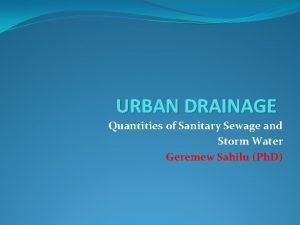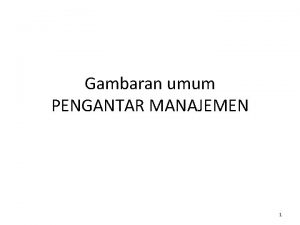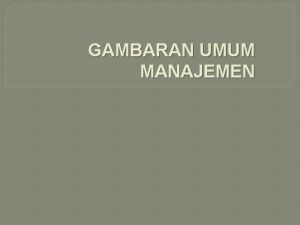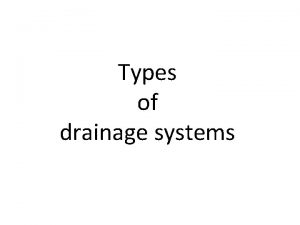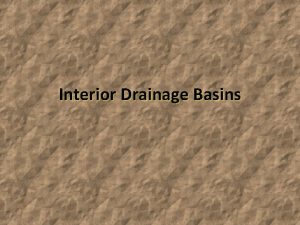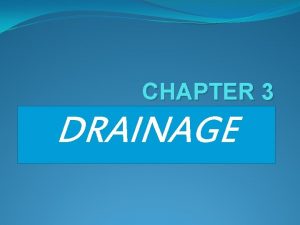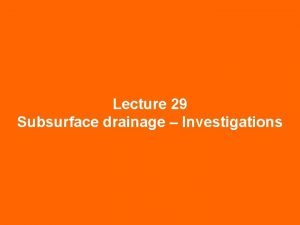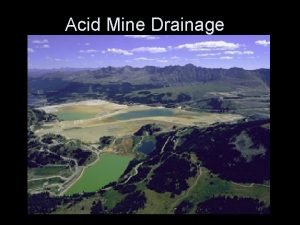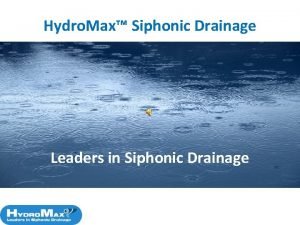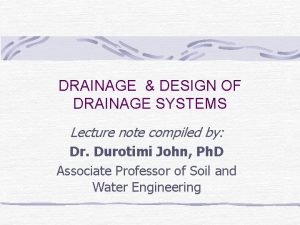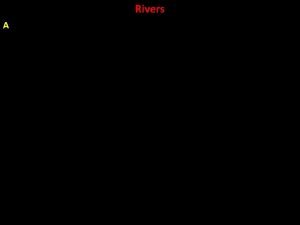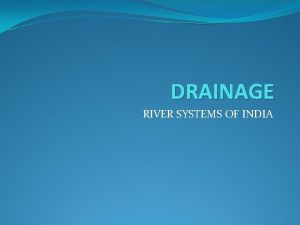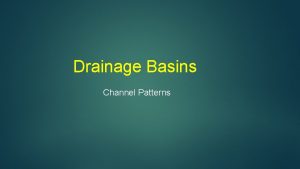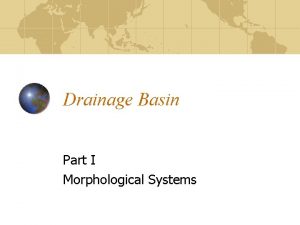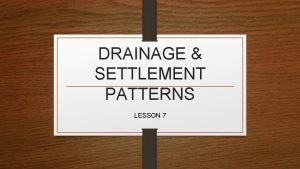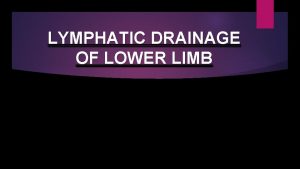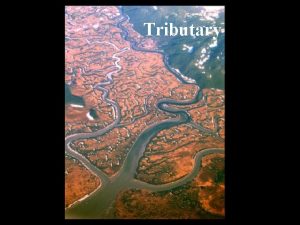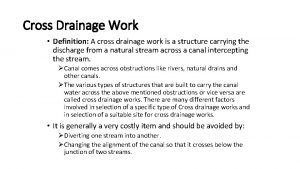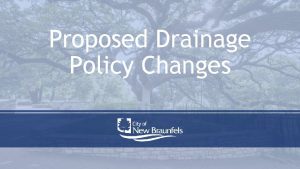Management of Drainage Water in Illinois Overview Defining

























- Slides: 25

Management of Drainage Water in Illinois

Overview �Defining the problem �Introducing drainage water management (DWM) How does it work? � Where does it apply? � Benefits � �Planning and applying the practice �Available resources Drainage Water Management Illinois

A Big Water Quality Issue � Hypoxic Zone or “Dead Zone” � Excess of nutrients (primarily nitrogen but also phosphorus and silica) � Algal growth organic matter sinks to bottom, decays, consumes available oxygen � Oxygen levels fall lower than 2 mg/l Drainage Water Management Illinois

Mississippi River Basin Average Annual Nitrogen Load in Streams N Load, lbs/acre Less than 1. 8 to 4. 4 4. 5 to 8. 9 9. 0 to 16. 0 16. 1 to 27. 1 Watershed Average = 2. 6 lbs/acre Drainage Water Management Illinois 4

Tile drained soils vs high nitrate levels Drainage Water Management Illinois 5

Problem Statement �Drainage is needed for economical crop production in many Illinois fields. �Tile drainage water is a primary source of nitrate to surface water. Drainage Water Management Illinois

What is Drainage Water Management? �The process of managing the water table elevation and the timing of water discharges from surface and subsurface agricultural drainage systems. �Theory: hold nutrients in field when drainage is not needed for production. Drainage Water Management Illinois

DWM on a Tile Line Water Level Control Structure Raised Water Table tch Solid pipe Di Drain Water Riser Boards (Adjustable) Drainage Water Management Illinois

Zone of Influence (Impacted Area) Lines labeled 600, 602, and 604 represent elevation contours

Nutrient Load Reduction FACT: Less flow from drainage tile Less nitrates to surface water NO 3 + carbon source + bacteria + time = N 2 gas Drainage Water Management Illinois

Management �Prior to field activities , remove flashboards �During growing season, manage water table to provide capillary water to root zone �During fallow season, raise water table (within 6” of the surface) Drainage Water Management Illinois

Example Management Strategy Drainage Water Management Illinois

Types of Tile Drain Systems �Patterned drainage Designed to uniformly drain the land �Random drainage Mostly in low spots Drainage Water Management Illinois

Drainage Management laterals (Parallel System and Flat Topography) main Water level control structure Drainage Water Management Illinois 14

Topographic Map with Tile Map Overlay

DWM Feasibility and Limitations • Economics • Flat topography (0. 5% average slope; minimum 15 -20 acre impacted area per structure) • Patterned (systematic) subsurface tile system exists • Tile map exists • Land Use • No negative impact on neighbors Drainage Water Management Illinois

Tile System Considerations �Goal: Efficiently drain water for field activities as needed, store water during the growing season to relieve summer crop stress, and reduce nitrogen loss during the fallow season. �Pattern Tile Design �Flat Land – conventional pattern tiling �Sloping Land– design for affected zones on the contour Drainage Water Management Illinois

Benefits of DWM As a part of a conservation system, DWM: �Improves water quality Documented 35 -81% nitrate load reduction in Illinois �Improves soil environment for better vegetative growth �Reduces rate of soil organic matter oxidation Drainage Water Management Illinois

Benefits of DWM As a part of a conservation system, DWM also can: �Reduce wind erosion and particulates (dust) �Enable seasonal flooding for wildlife habitat Drainage Water Management Illinois

DWM Yield Benefits? �Research is inconclusive on yield benefits �Weather is a big factor – yield improvement has good potential in dry years �Anecdotal evidence suggests as much as 10 -20% yield improvement in some years Drainage Water Management Illinois

Implementation Plan Design Install Manage �Conservation plan � � � DWM Plan (CAP 130) is a good start Systems approach: suite of practices Nutrient Management is especially beneficial �Infrastructure to facilitate management � Implement practices from conservation plan �Management (active) Drainage Water Management Illinois

Contents of a DWM Plan �ID and location info �Objectives �Maps and delineations �Control structure summary table �Management instructions �Signature page http: //www. wq. illinois. edu/DG/Drainage. Guide. html Drainage Water Management Illinois

Potential DWM Acres in Illinois • Flat cropland • Likely to be tile drained • Minimum 15 acre parcels Simplification: land ownership and tile configuration not considered By the Numbers: • 24 million cropland acres • 10 million drained • ~2 million suitable for DWM Drainage Water Management Illinois

Available Financial Assistance �Environmental Quality Improvement Program (EQIP) �Contact your local NRCS field office for more information Drainage Water Management Illinois

NRCS: Helping People Help The Land www. nrcs. usda. gov USDA is an equal opportunity provider and employer.
 Relative clauses defining and non-defining
Relative clauses defining and non-defining Relative clauses defining and non defining
Relative clauses defining and non defining Defining and non defining relative clauses
Defining and non defining relative clauses Defining relative clause meaning in telugu
Defining relative clause meaning in telugu Defining non defining farkı
Defining non defining farkı Finite relative clause
Finite relative clause Water and water and water water
Water and water and water water Sewage and storm water estimation
Sewage and storm water estimation Bubbling in water seal chamber
Bubbling in water seal chamber Ce certification electric water pump design
Ce certification electric water pump design Sex offender evaluation illinois
Sex offender evaluation illinois Defining risk management
Defining risk management Content management system database
Content management system database Human resource management overview
Human resource management overview Management topics for project
Management topics for project Gym management system comparison
Gym management system comparison Market overview real-time interaction management
Market overview real-time interaction management Management overview
Management overview Peta konsep manajemen ekonomi
Peta konsep manajemen ekonomi Overview of financial management
Overview of financial management The commonly accepted goal of the mnc is to:
The commonly accepted goal of the mnc is to: Chapter 1 an overview of financial management
Chapter 1 an overview of financial management An overview of financial management
An overview of financial management Drainage basin
Drainage basin Dorsal digital vein
Dorsal digital vein Two pipe plumbing system
Two pipe plumbing system







